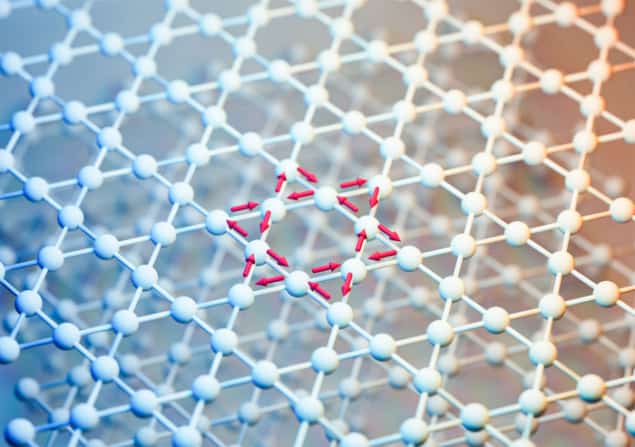
Exotic materials known as kagome superconductors can play host to a rare state of matter in which electric currents form “loops” around unit cells in the material’s crystalline lattice. This discovery, made by researchers at Switzerland’s Paul Scherrer Institute (PSI) together with international collaborators, could reveal new information about how superconductivity emerges in materials where complex effects such as frustrated magnetism and intertwined orders play a major role.
Kagome metals are named after a traditional Japanese basket-weaving technique that produces a lattice of interlaced, corner-sharing symmetrical triangles. When the atoms of a metal or other conductor are arranged in this so-called kagome pattern, their electrons behave in unusual ways, giving rise to interaction-driven electronic phases of matter that can be identified by studying symmetries of the material.
In one such electronic phase, electrons organize themselves into a looped pattern along the kagome bonds between regions of the lattice with high and low concentrations of electric charge. Researchers have long debated whether such unusual loop currents could be a precursor to important condensed-matter phenomena such as high-temperature superconductivity (the ability to conduct electricity without resistance below critical temperatures of 77 K or higher) or the quantum anomalous Hall effect, in which a material exhibits a quantized voltage drop in a direction transverse to the flow of an electric current even in the absence of an external magnetic field.
A rare state of matter
A multinational team led by scientists at the PSI’s Laboratory for Muon Spin Spectroscopy has now identified a signature of such a phase in a kagome superlattice material with the chemical formula KV3Sb5, which becomes a superconductor at a critical temperature of 1.2 K. After spotting the weak internal magnetic fields that indicate the presence of charge ordering, the researchers also found evidence that these magnetic fields break “time-reversal symmetry”, which requires the laws of physics to look the same irrespective of whether time moves forwards or backwards.
To detect the tell-tale signs of time-reversal-symmetry breaking, the physicists used a technique called muon spin rotation/relaxation spectroscopy (uSR). Muons are elementary particles that are similar to electrons but have more than 200 times the electron’s mass. They have a finite lifetime, and at the end of it, they decay into lighter particles such as positrons, which are the antiparticles of electrons.
In the current study, which is described in Nature, the physicists implanted muons into their sample of KV3Sb5. The muons interact with their local environment via their internal angular momentum, which is sensitive to magnetic fields produced by electronic current loops. This means that as the muons decay into positrons, the way the polarization of the angular momentum evolves with time changes in a manner that signifies the presence of such loops.
Quantum anomalous Hall effect could come from orbital currents
The team observed a systematic shift in the magnetic signal and concluded that time-reversal symmetry breaks in KV3Sb5 at 80 K, the temperature at which the current loops form. Interestingly, the material also exhibits a giant quantum anomalous Hall effect at this temperature. This effect was previously unexplained, but the PSI researchers say their result provides the best evidence yet that it stems from orbital currents. This hypothesis, long debated for Kagome superlattices, could also apply to other unconventional superconductors that exhibit a large quantum anomalous Hall effect, such as graphene.
“Normally, these loop currents are hard to detect since their signals are usually too weak,” explains team leader Zurab Guguchia. “We overcame this problem by applying a high magnetic field of up to 9.5 Tesla to amplify the electronic response.”

Kagome geometry produces magnetism in a 2D organic material
The researchers say that their discovery of time-reversal symmetry-breaking fields – which implies both orbital currents and the peculiar charge ordering that gives rise to them – opens doors to “exotic avenues of physics and next-generation device research”. They add that the concept of orbital currents also forms the basis of “orbitronics”, in which the orbital degree of freedom is used as an information carrier in solid-state devices.
The researchers acknowledge that there is as yet no consensus on the superconducting gap structure in kagome materials with the formula AV3Sb5 (where A can be K, Rb or Cs). They attribute this lack of consensus to “the challenges of performing spectroscopic studies under extreme conditions including ultra-low temperatures and large pressures”. They plan to tackle these barriers by performing zero-field, high-field and high-pressure muon spin relaxation experiments to directly probe the interplay between chiral charge order and superconductivity across the temperature-pressure phase diagram of AV3Sb5. “This will allow us to assess not only the time-reversal symmetry-breaking nature of these two states, but also the evolution of the low-energy superconducting excitations as charge order is suppressed under pressure,” Guguchia tells Physics World.



